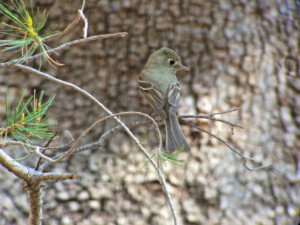By Louise Misztal
Five years ago I wrote—in the pages of this very newsletter—about the effects of climate change that were already visible in the Sky Islands and that the region’s ecosystems and species were facing new and more complex challenges as a result. What I wrote then is still true to today.
“[W]arming has contributed to increases in wildfire activity, changes in the timing of species’ lifecycle events, and ecological changes in habitats. To further complicate matters, climate changes are interacting with other stressors such as decades-long drought, human land use, habitat fragmentation, and complex ecosystem interactions to create measurable and sometimes drastic changes in the region.”
from Restoring Connections, vol. 14 issue 2, Summer 2011
In my 2011 article, wildfire was at the forefront—with fires raging across the West, including parts of the Sky Island Region. As I write today, climate change is no less pressing. In fact all the evidence points to more rapid warming, increased storm intensity, and greater wildfire risk—but there are also clear and promising signs that species are finding ways to adapt.
 Climate change often feels abstract, with the impacts occurring in places we only hear about on the news. But earlier this year, when a female pine flycatcher (Empidonax affinis) showed up in the Santa Rita Mountains near Tucson, the local impacts of climate change came into focus.
Climate change often feels abstract, with the impacts occurring in places we only hear about on the news. But earlier this year, when a female pine flycatcher (Empidonax affinis) showed up in the Santa Rita Mountains near Tucson, the local impacts of climate change came into focus.
This was the first sighting in the United States of this small, energetic bird that makes its living hawking insects in forested habitat. This intrepid female, whose traditional range runs from northeastern Mexico through Guatemala, showed up early this summer at Aliso Spring, one of seven Adopt-a-Spring sites monitored by Sky Island Alliance. She spent the month of June building a nest—an unusual investment for a lone individual of a species.
Aliso Spring faces many current and potential threats, not least of which is that it sits in the same groundwater basin likely to be severely depleted by the proposed Rosemont Mine. Yet, this little trailblazer of a bird found safe haven here. Sky Island Alliance is proud to have played a part in protecting this important resource. Through our springs inventory, monitoring, and restoration work, we are securing important habitat for the species that need it now—and for those we haven’t even considered might find sanctuary there in the future.
Spring supported habitats make up a tiny fraction of the regional landscape but provide unique and critical pockets of cool, wet respite for wildlife and plants, giving them a better chance to survive and adapt in an uncertain future.
The U.S.–Mexico border cuts through the heart of the Sky Islands on human maps, but birds, bears, coati, big cats, and all the other amazing residents—and ecosystems—of the region don’t recognize this political boundary.
As I wrote in 2011, Sky Island Alliance is not sitting by idly while habitat disappears and species are impacted. We have worked throughout our history to connect people and habitat—without regard for borders—and this work is more pressing than ever as wildlife and plants shift their ranges farther north and higher in elevation seeking suitable habitat. One of the initiatives we launched in 2011 was Adapting to a Changing Climate in the Sky Island Region. Through that initiative,
“Federal, tribal, state, and county agency personnel; academic and agency researchers; conservation organizations; and private landowners developed key strategies for addressing climate change, including solutions-oriented ways we can work together to ensure that the entire Sky Island Region is adequately protected.”
from Restoring Connections, vol. 14 issue 2, Summer 2011
We are building on early results of this initiative in a number of ways: restoring watersheds that have suffered from severe fire to help them transition while providing food and cover for wildlife; addressing pollinator habitat needs by restoring native flowering plants; mapping and working to protect the most important linkages for wildlife in a changing climate; and eliminating stressors not related to climate, such as damaging roads and invasive species.
In addition, we continue our work to identify and survey more sites like Aliso Spring, documenting locations, the amount of water available and seasonal changes to flow, and which wildlife and plants are present to focus our restoration efforts where the most important springs are found.
As climate disruption continues to change our local environments and impact wildlife, one tangible thing we can do is protect these safe and inviting habitats where they exist to give pioneers, like the pine flycatcher, a place to call home when they abandon warmer climes farther south or at lower elevations. This is our duty as citizens of this unique region.
You can help. Email Conservation Coordinator Samantha Hammer to join our Adopt-a-Spring program and monitor these magical sites throughout the year—you never know what might turn up! Or join us in the field for a volunteer work day or weekend camping and work trip. To discover opportunities, sign up for our volunteer email announcements or email our Restoration Director, Carianne Campbell.
You can also support this important work with a donation. Make a gift today to ensure safe havens for wildlife throughout the Sky Islands.
